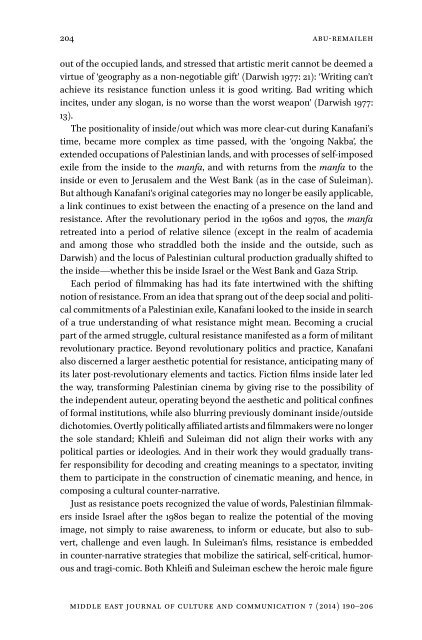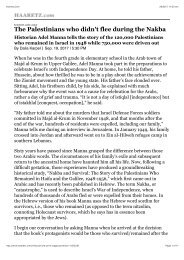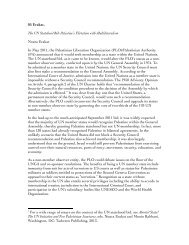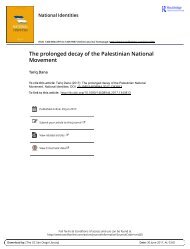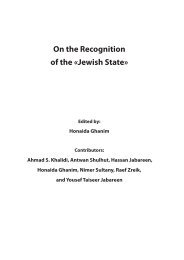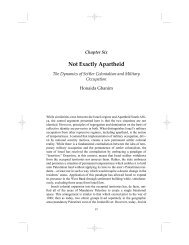The Kanafani Effect: Resistance and Counter-Narration in the Films of Michel Khleifi and Elia Suleiman
Guided by Ghassan Kanafani’s seminal studies on ‘resistance literature’, this paper extends the concept to contemporary Palestinian fiction film to explore its permuta- tions in the visual medium. - By Refqa Abu-Remaileh
Guided by Ghassan Kanafani’s seminal studies on ‘resistance literature’, this paper extends the concept to contemporary Palestinian fiction film to explore its permuta- tions in the visual medium. - By Refqa Abu-Remaileh
You also want an ePaper? Increase the reach of your titles
YUMPU automatically turns print PDFs into web optimized ePapers that Google loves.
204 abu-remaileh<br />
out <strong>of</strong> <strong>the</strong> occupied l<strong>and</strong>s, <strong>and</strong> stressed that artistic merit cannot be deemed a<br />
virtue <strong>of</strong> ‘geography as a non-negotiable gift’ (Darwish 1977: 21): ‘Writ<strong>in</strong>g can’t<br />
achieve its resistance function unless it is good writ<strong>in</strong>g. Bad writ<strong>in</strong>g which<br />
<strong>in</strong>cites, under any slogan, is no worse than <strong>the</strong> worst weapon’ (Darwish 1977:<br />
13).<br />
<strong>The</strong> positionality <strong>of</strong> <strong>in</strong>side/out which was more clear-cut dur<strong>in</strong>g <strong>Kanafani</strong>’s<br />
time, became more complex as time passed, with <strong>the</strong> ‘ongo<strong>in</strong>g Nakba’, <strong>the</strong><br />
extended occupations <strong>of</strong> Palest<strong>in</strong>ian l<strong>and</strong>s, <strong>and</strong> with processes <strong>of</strong> self-imposed<br />
exile from <strong>the</strong> <strong>in</strong>side to <strong>the</strong> manfa, <strong>and</strong> with returns from <strong>the</strong> manfa to <strong>the</strong><br />
<strong>in</strong>side or even to Jerusalem <strong>and</strong> <strong>the</strong> West Bank (as <strong>in</strong> <strong>the</strong> case <strong>of</strong> <strong>Suleiman</strong>).<br />
But although <strong>Kanafani</strong>’s orig<strong>in</strong>al categories may no longer be easily applicable,<br />
a l<strong>in</strong>k cont<strong>in</strong>ues to exist between <strong>the</strong> enact<strong>in</strong>g <strong>of</strong> a presence on <strong>the</strong> l<strong>and</strong> <strong>and</strong><br />
resistance. After <strong>the</strong> revolutionary period <strong>in</strong> <strong>the</strong> 1960s <strong>and</strong> 1970s, <strong>the</strong> manfa<br />
retreated <strong>in</strong>to a period <strong>of</strong> relative silence (except <strong>in</strong> <strong>the</strong> realm <strong>of</strong> academia<br />
<strong>and</strong> among those who straddled both <strong>the</strong> <strong>in</strong>side <strong>and</strong> <strong>the</strong> outside, such as<br />
Darwish) <strong>and</strong> <strong>the</strong> locus <strong>of</strong> Palest<strong>in</strong>ian cultural production gradually shifted to<br />
<strong>the</strong> <strong>in</strong>side—whe<strong>the</strong>r this be <strong>in</strong>side Israel or <strong>the</strong> West Bank <strong>and</strong> Gaza Strip.<br />
Each period <strong>of</strong> filmmak<strong>in</strong>g has had its fate <strong>in</strong>tertw<strong>in</strong>ed with <strong>the</strong> shift<strong>in</strong>g<br />
notion <strong>of</strong> resistance. From an idea that sprang out <strong>of</strong> <strong>the</strong> deep social <strong>and</strong> political<br />
commitments <strong>of</strong> a Palest<strong>in</strong>ian exile, <strong>Kanafani</strong> looked to <strong>the</strong> <strong>in</strong>side <strong>in</strong> search<br />
<strong>of</strong> a true underst<strong>and</strong><strong>in</strong>g <strong>of</strong> what resistance might mean. Becom<strong>in</strong>g a crucial<br />
part <strong>of</strong> <strong>the</strong> armed struggle, cultural resistance manifested as a form <strong>of</strong> militant<br />
revolutionary practice. Beyond revolutionary politics <strong>and</strong> practice, <strong>Kanafani</strong><br />
also discerned a larger aes<strong>the</strong>tic potential for resistance, anticipat<strong>in</strong>g many <strong>of</strong><br />
its later post-revolutionary elements <strong>and</strong> tactics. Fiction films <strong>in</strong>side later led<br />
<strong>the</strong> way, transform<strong>in</strong>g Palest<strong>in</strong>ian c<strong>in</strong>ema by giv<strong>in</strong>g rise to <strong>the</strong> possibility <strong>of</strong><br />
<strong>the</strong> <strong>in</strong>dependent auteur, operat<strong>in</strong>g beyond <strong>the</strong> aes<strong>the</strong>tic <strong>and</strong> political conf<strong>in</strong>es<br />
<strong>of</strong> formal <strong>in</strong>stitutions, while also blurr<strong>in</strong>g previously dom<strong>in</strong>ant <strong>in</strong>side/outside<br />
dichotomies. Overtly politically affiliated artists <strong>and</strong> filmmakers were no longer<br />
<strong>the</strong> sole st<strong>and</strong>ard; <strong>Khleifi</strong> <strong>and</strong> <strong>Suleiman</strong> did not align <strong>the</strong>ir works with any<br />
political parties or ideologies. And <strong>in</strong> <strong>the</strong>ir work <strong>the</strong>y would gradually transfer<br />
responsibility for decod<strong>in</strong>g <strong>and</strong> creat<strong>in</strong>g mean<strong>in</strong>gs to a spectator, <strong>in</strong>vit<strong>in</strong>g<br />
<strong>the</strong>m to participate <strong>in</strong> <strong>the</strong> construction <strong>of</strong> c<strong>in</strong>ematic mean<strong>in</strong>g, <strong>and</strong> hence, <strong>in</strong><br />
compos<strong>in</strong>g a cultural counter-narrative.<br />
Just as resistance poets recognized <strong>the</strong> value <strong>of</strong> words, Palest<strong>in</strong>ian filmmakers<br />
<strong>in</strong>side Israel after <strong>the</strong> 1980s began to realize <strong>the</strong> potential <strong>of</strong> <strong>the</strong> mov<strong>in</strong>g<br />
image, not simply to raise awareness, to <strong>in</strong>form or educate, but also to subvert,<br />
challenge <strong>and</strong> even laugh. In <strong>Suleiman</strong>’s films, resistance is embedded<br />
<strong>in</strong> counter-narrative strategies that mobilize <strong>the</strong> satirical, self-critical, humorous<br />
<strong>and</strong> tragi-comic. Both <strong>Khleifi</strong> <strong>and</strong> <strong>Suleiman</strong> eschew <strong>the</strong> heroic male figure<br />
Middle East Journal <strong>of</strong> Culture <strong>and</strong> Communication 7 (2014) 190–206


